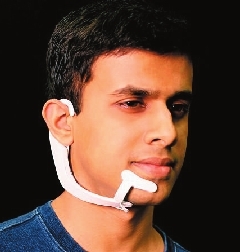
读心术真的来了 A new mind-reading device means people can silently type on their computer using nothing but thoughts and it’s accurate 90 percent of the time. Instead of communicating with smart devices by saying “Ok Google” or “Hey Siri,” the headset silently interprets what users are thinking, giving them “superpowers,” researchers say. When people think about verbalizing* something, the brain sends signals to facial muscles even if nothing is said aloud. The device has sensors that pick up seven key areas along the cheek, jaw and chin that can recognize words and can even talk back once it has processed them. Other companies, such as Elon Musk’s Neuralink, are also developing Matrix-style computer-brain interfaces to give people advanced mental abilities. Currently the AlterEgo device, which was created by researchers from MIT Media Lab, can recognize digits 0 to 9 and has a vocabulary of around 100 words. ”It gives you superpowers,” said graduate student Arnav Kapur, who created the device with Pattie Maes. The system consists of a wearable device and an associated computing system which is directly linked to a program that can query Google. Electrodes* in the device pick up neuromuscular* signals in the jaw and face which are triggered when users say words “in their head.” The signals are fed to a machine-learning system that has been trained to correlate particular signals with particular words. The device also includes a pair of bone-conduction headphones, which transmit vibrations through the bones of the face to the inner ear. These headphones do not obstruct the ear canal so users can still hear information without their conversations being interrupted. (SD-Agencies) | 
